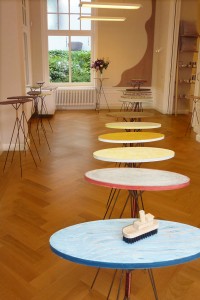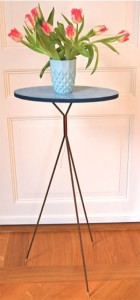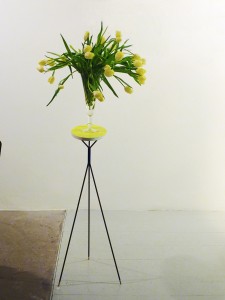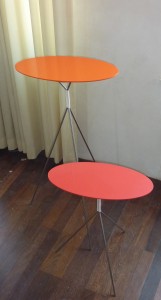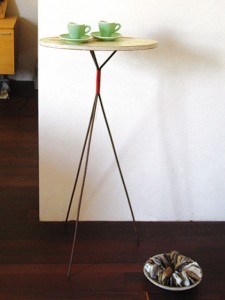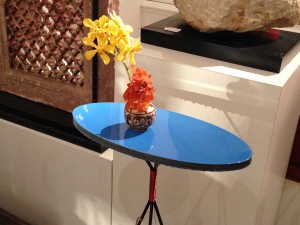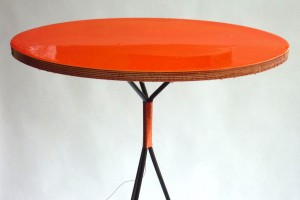While driving through the Rotterdam harbor, van Dansik As a construction the Ndebele table is so light that it can easily be moved around. As a consequence of the tripod construction it will be stable wherever it is placed. As a pedestal it is surprisingly strong and capable of supporting objects up to 5 kilo. The light and airy design makes the table blend in easily almost everywhere. It is likely to lead a nomadic existence in your house, moving from one spot to another. It will go wherever you need it to be. The Ndebele table has been produced in a limited handmade series of 25 individual tables. They vary in the metal chosen for the hoofs, the legs and the wire and in the material used for the tabletop. There is for example the ‘Peek & Cloppenburg’ table, with a top made of reclaimed teak-floorboards. “This teak is about a century old. You can’t get that quality anymore”, he explains. By combining the teak with oak and pangapanga, around a plywood center, an extremely durable and beautiful parquetry occurs.
Iedereen kent wel een driepoot tafeltje. Het is de meest eenvoudige manier om een tafel te maken die niet wiebelt. De eenvoud zelve, niet te verbeteren. Ik ben op onderzoek gegaan naar het detail dat naar mijn mening vaak niet goed is opgelost in een dergelijke constructie: het punt waar de 3 stokken bij elkaar komen.
Door te kiezen voor het samenbinden van de poten ontstaat een eigenzinnig beeld van een nekje dat me sterk doet denken aan de vrouwen van een afrikaanse stam die elk jaar weer een volgende zilveren band om hun hals geslagen krijgen.
Als constructie is het NDEBELE TAFELTJE verbazingwekkend sterk en stevig, het kan een gewicht van 5 kg makkelijk dragen.
came across an abandoned bundle of iron rods. Without
even getting out of his Citroen 2CV, he reached out and took them aboard.
The rods became table legs as van Dansik set out to create a tripod. In exploring ways to keep the legs and the table top steadily together, van Dansik found a solution that was not only stunningly clever and functional, it defined the iconic Ndebele table. In joining the legs by winding metal wire around them, a long ringed neck emerged, very much alike the ringed necks of the Ndebele women.
> Ndebele table history
NDEBELE TAFELTJE
